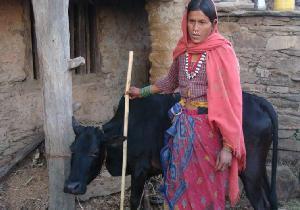Surendra Wagle
Other projects
The major aim of this project is to contribute institutional strengthening and awareness raising for sustainable conservation of critically endangered Achhami Cattle and avoiding impact of current practices of cross breeding that threatens the genetic purity of cattle.

Achhami Cattle Conservation Awareness Project (ACCAP), Nepal, the first RSG project has investigated that the smallest indigenous cattle breed of the world, originated at Achham district, adaptability to local harsh conditions, registered in Food and Agriculture Organization (FAO), less than one metre tall and can be domesticated in low input systems and resistance to diseases is 863 (DLSO Achham) in number. Out of them 378 are female due to illegal trading towards Tibet.

The major aim of this project is to contribute sustainable conservation and impact of current practices of cross breeding of the Cattle that threatens the genetic purity of cattle. For this purpose, activities like interaction programs, extension of cattle rearing group, census of the cattle population, workshops and publication of wall calendar and republication of book will be carried out to disseminate knowledge locally, nationally and globally through www.achhamicattle.com
When female population is less than 500 and male population is 20, the species is critically endangered. Donating at least one cattle to purify the house impure by deceased family member and restriction to buy those cattle by others will gather many cattle in priest’s cowshed and cattle are sold towards Tibet. DLSO, Achham has conducted some regular programs like drenching, vaccination, milk recording, fodder/forage sapling support, hanging hording boards, improving cowshed, exchanging bullocks to prevent inbreeding. Animal Breeding Division has stored about 500 doses of semen of Achhami Bullock for artificial insemination (AI). Grazing on same pastureland with other bullocks and lack of proper strategy for breeding, cross breeding prevails. Shifting livelihood pattern of people and development of community forest, people rear fewer cattle. As locals know smallest indigenous cattle breed of the world, originated at Achham district, registered in Food and Agriculture Organization (FAO), has 863 (DLSO Achham) in total number and female is 378 and categorised as critically endangered due to illegal trading from Brahmins cowshed, they will change the traditional culture and buy the cattle from Brahmin’s which reduces the illegal trading and farmers will get several benefits like milk and organic manure that increases soil fertility and crop productivity and livelihood of poor farmers will be better.
The interaction, workshop and essay competition explore that the species is the smallest cattle breed of the world found only in Achham district and motivate the local people to check inbreeding and cross breeding. Incentive given to the cattle-rearing group to improve the traditional cowshed and extension of cattle rearing group will motivate the local for the sustainable in-situ conservation. Distribution of books and wall calendar will highlight the importance of indigenous animal genetic resources in Nepal.